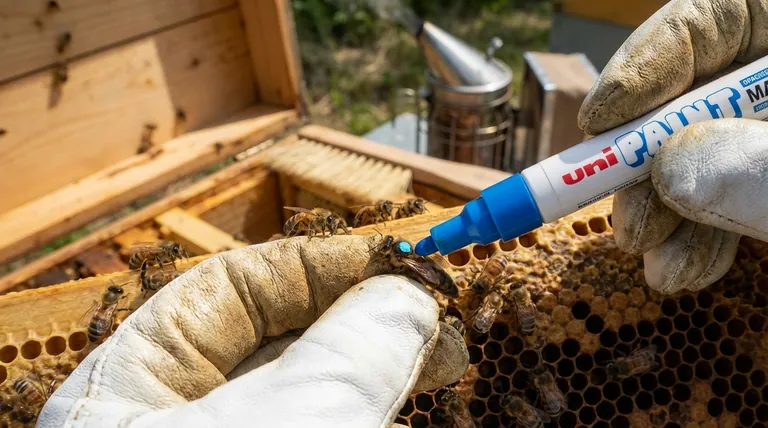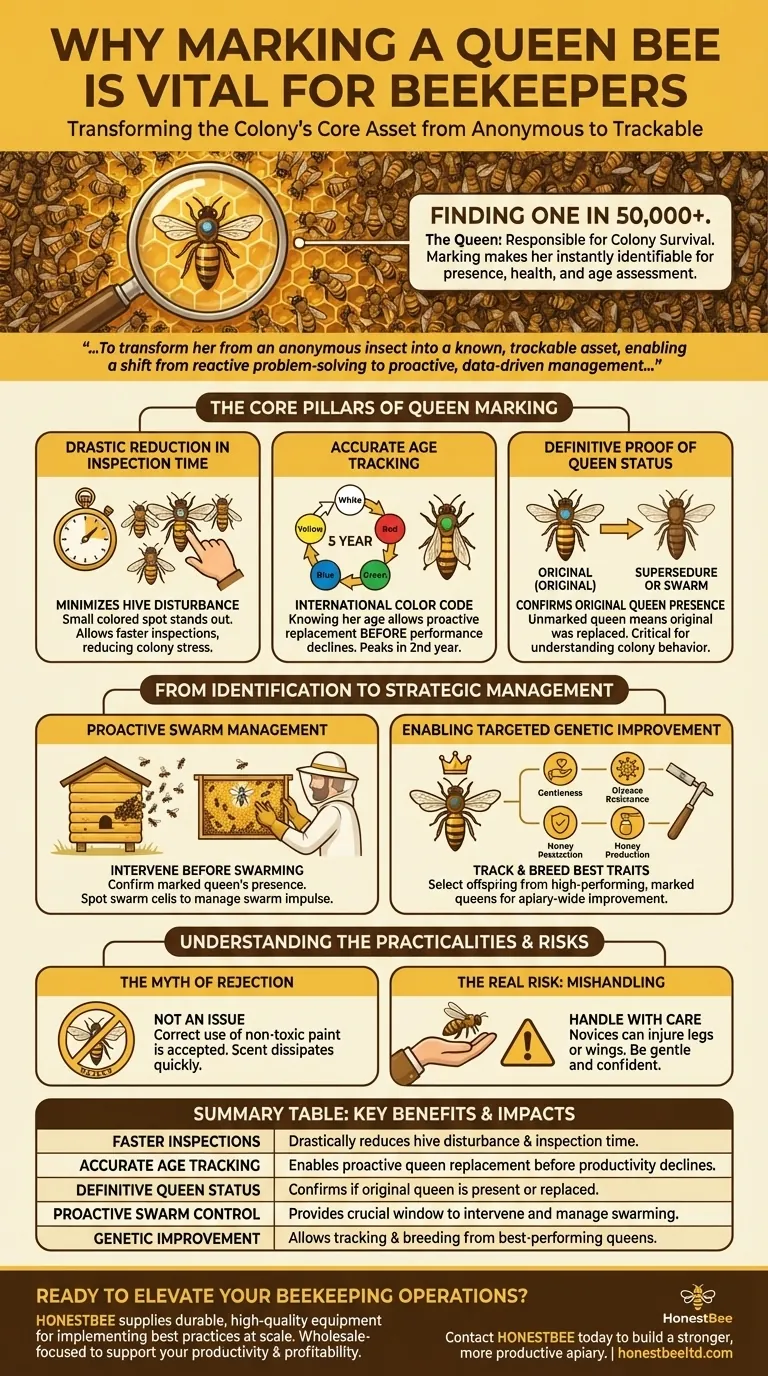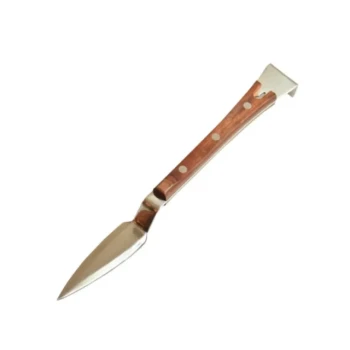In a hive of over 50,000 bees, finding the one responsible for the colony's survival—the queen—can be an incredibly difficult task. Marking a queen bee with a small, colored dot on her thorax is a simple procedure that makes her instantly identifiable. This allows a beekeeper to quickly assess her presence, health, and age, which are fundamental data points for effective hive management.
The core reason to mark a queen isn't just to find her faster. It's to transform her from an anonymous insect into a known, trackable asset, enabling a shift from reactive problem-solving to proactive, data-driven management of the entire colony's health and productivity.

The Core Pillars of Queen Marking
Marking provides immediate and long-term benefits that are pillars of modern beekeeping. Each benefit builds upon the last, providing a more complete picture of the colony's status with every inspection.
Drastic Reduction in Inspection Time
The most immediate advantage is speed. A small spot of color on the queen's back stands out clearly against the thousands of her moving daughters.
Finding the queen quickly reduces the amount of time the hive is open and disturbed. This minimizes stress on the colony and allows the beekeeper to perform inspections more efficiently.
Accurate Age Tracking
Beekeepers use an international color code that assigns a specific color to each year, repeating on a five-year cycle. This system makes it possible to know a queen's age at a glance.
A queen's egg-laying productivity typically peaks in her second year and declines thereafter. Knowing her age allows you to anticipate this decline and plan to replace her before her failing performance weakens the colony.
Definitive Proof of Queen Status
Bees will sometimes replace their queen without the beekeeper's knowledge in an event called supersedure, or the original queen may leave with a swarm.
If you open a hive and find an unmarked queen, you know definitively that your original, marked queen has been replaced. This single piece of information is critical for understanding recent colony behavior and updating your records. Conversely, seeing your marked queen confirms the colony is stable.
From Identification to Strategic Management
With the queen's identity and age confirmed, a beekeeper can move beyond simple observation and into strategic decision-making that influences the colony's future success.
Proactive Swarm Management
Swarming is a natural reproductive impulse, but it results in the loss of up to half the hive's population and the original, proven queen.
By easily locating your marked queen, you can confirm she is still present. If you then see swarm cells being built, you know the colony is preparing to swarm. This gives you a crucial window to intervene and manage the swarm impulse.
Enabling Targeted Genetic Improvement
For beekeepers who raise their own queens, marking is essential. It allows you to track which queens produce colonies with the most desirable traits, such as gentleness, disease resistance, or high honey production.
When you decide to graft larvae to raise new queens, you can confidently select from the offspring of your best-performing, marked queen, thereby improving the genetic quality of your entire apiary over time.
Understanding the Practicalities and Risks
While marking is overwhelmingly beneficial, it's a manual process that requires care. Understanding the minimal risks involved is part of responsible beekeeping.
The Myth of Rejection
A common concern is that the other bees will reject or harm a queen because of the paint. When done correctly with non-toxic, quick-drying bee-marking paint or pens, this is not an issue. The scent dissipates quickly, and the colony accepts the marked queen without incident.
The Real Risk: Mishandling
The primary risk is not the mark itself, but the act of catching and handling the queen. She is the single most important bee in the colony, and a novice can inadvertently injure her legs, wings, or abdomen. It is vital to be gentle and confident when holding her for the few seconds it takes to apply the mark.
Should You Mark Your Queen?
The decision to mark your queen ultimately depends on your beekeeping goals. For most, the benefits significantly outweigh the minimal risks.
- If your primary focus is learning and small-scale management: Marking is an invaluable tool that accelerates your ability to find the queen and assess colony status quickly.
- If your primary focus is productivity and honey production: Marking is essential, as it allows you to track the age and performance of your most critical asset and replace her before production drops.
- If your primary focus is queen rearing and genetic improvement: Marking is non-negotiable. It is the only way to definitively track, validate, and breed from your best genetic stock.
Ultimately, marking a queen is a simple action that elevates beekeeping from a reactive hobby to a strategic agricultural practice.
Summary Table:
| Benefit | Key Impact |
|---|---|
| Faster Inspections | Drastically reduces hive disturbance and inspection time. |
| Accurate Age Tracking | Enables proactive queen replacement before productivity declines. |
| Definitive Queen Status | Confirms if the original queen is present or has been replaced. |
| Proactive Swarm Control | Provides a crucial window to intervene and manage swarming. |
| Genetic Improvement | Allows tracking and breeding from the best-performing queens. |
Ready to elevate your beekeeping operations with professional-grade equipment?
As a commercial beekeeper or distributor, managing your colonies efficiently is key to your success. HONESTBEE supplies the durable, high-quality beekeeping supplies and equipment you need to implement best practices like queen marking at scale. Our wholesale-focused operations are designed to support your productivity and profitability.
Contact HONESTBEE today to discuss your equipment needs and discover how we can help you build a stronger, more productive apiary.
Visual Guide

Related Products
- Queen Bee Marking Pen UNI Medium Point for Queen and Bee Marking
- HONESTBEE 15-in-1 Beekeeper Multi-Tool with Hammer and Pliers for Beekeeping
- HONESTBEE Premium Italian Style Hive Tool with Hardwood Handle
- Jenter Queen Rearing Kit Complete Set for Bee Breeding
- Professional Engraved Round Hive Number Tags for Beekeeping
People Also Ask
- What is the process for priming a paint pen before marking a Queen bee? Ensure a Safe, Quick Marking Procedure
- What is the purpose of a queen marking pen in beekeeping? Essential for Efficient Hive Management
- What are the advantages of using Uni-Posca markers for Queen marking? A Safe, Precise, and Efficient Solution
- What are the benefits of marking queen bees? Boost Hive Health & Management Efficiency
- What type of markers are commonly used for marking Queen bees? Choose the Safe, Non-Toxic Standard



















